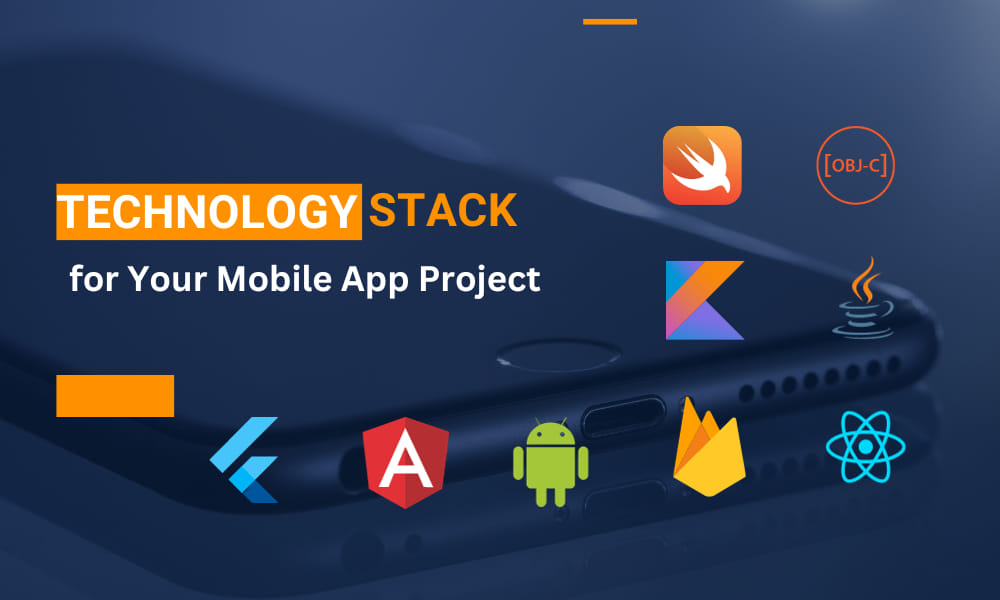In today’s fast-paced tech sphere, the importance of developing a resilient mobile app is more crucial than ever. Given that a user spends around 3 hours and 15 minutes daily on their smartphones, businesses are eager to grab their focus by crafting effective and engaging apps.

However, getting into mobile app development without proper research might set you up for a stepback. One of the preliminary, and perhaps the most important decisions, revolves around cherry-picking the right technological foundation for your app.
Why is the Technology Stack Important?
- Performance and Scalability: Opting for the ideal stack guarantees fluid performance and can accommodate growing user traffic as your app rises in popularity.
- Development Speed: Certain tech stacks can fast-track the creation process, ensuring a swifter launch in the marketplace.
- Budget Considerations: The developmental cost can fluctuate depending on the chosen technologies. Some open-source avenues can be a wallet-friendly choice.
- Ongoing Maintenance & Support: Modern, well-endorsed technologies simplify the task of app maintenance and updates.
Factors to Consider When Choosing a Technology Stack
- Type of Application: The intricacy and nature of your app will shape the tech stack selection. For instance, a straightforward content-centric app may have distinct tech stack needs compared to a complex, interactive app or a gaming venture.
- Development Cost: Budgetary shackles are a common reality. It’s imperative to align the stack choice with your financial outline. Open-source tech could be a cost-effective option.
- Development Team’s Expertise: If your team has rich expertise with certain technologies, employing those could speed up development and amplify the quality of the final product.
- Platform Coverage: The decision between iOS, Android, or both, will heavily sway your tech stack selection. Cross-platform frameworks could be a winning ticket if you’re aiming for a broader audience.
- Future Maintenance and Scalability: Forethought towards easy future maintenance, upgrades, and scalability in tune with user growth is advisable.
- Community and Documentation: A vibrant community and well-chronicled technologies can considerably smooth out the development trail. They’re treasure troves for troubleshooting, learning, and third-party tools.
- Testing and Debugging: Tech stacks armed with robust testing and debugging tools can drastically slash the time spent on bug hunting, leading to a more robust and reliable app.
Popular Technology Stacks for Mobile App Development
Half the battle understands what you need. Now, let’s explore some of the highly favoured app development platforms and their associated tech stacks.
- Native Mobile App Platform
In the realm of mobile app development, native apps hold a distinct position as they are meticulously crafted for specific mobile operating systems. They are acknowledged for rendering optimal performance and leveraging the full range of platform capabilities. Let’s delve into the prominent tech stacks employed in the development of native mobile apps:
For iOS:
- Language:
Swift: Known for its robustness and intuitive nature, Swift has emerged as a premier programming language for iOS, macOS, watchOS, and tvOS. It’s celebrated for its performance-centric attributes and developer-friendly features.
Objective-C: Despite Swift gaining a stronghold, Objective-C, being a time-tested language in the Apple ecosystem, continues to find its application in certain legacy projects.
- IDE (Integrated Development Environment):
Xcode: As Apple’s official IDE, Xcode presents a comprehensive suite of tools essential for the development and debugging of applications for the Apple ecosystem.
- Tools and Frameworks:
Cocoa Touch: This UI framework is instrumental in constructing software programs tailored for iOS, catering to both iPhone and iPod Touch, along with iPadOS.
For Android:
- Language:
Kotlin: As a modern, statically typed language, Kotlin is recognized for its conciseness, safety features, and seamless interoperability with Java.
Java: Despite being a traditional language for Android development, Java’s robustness is undeniable, although it may demand more code than Kotlin.
- IDE:
Android Studio: This official IDE for Android development extends support for both Java and Kotlin, streamlining the development process.
- Tools and Frameworks:
Android SDK (Software Development Kit): This kit furnishes the essential tools and APIs, paving the way for Android development within the Android Studio IDE.
Firebase: Developed by Google, Firebase is a comprehensive platform for creating mobile and web applications. It encapsulates a multitude of tools and services spanning analytics, databases, messaging, and beyond.
- Hybrid/Cross-Platform Mobile App Platform
The allure of hybrid or cross-platform frameworks lies in their ability to allow developers to pen down code once and execute it across multiple platforms, thus economizing on development time and costs.
React Native: Developed by Facebook, React Native empowers developers to script in JavaScript and render it utilizing native components. Its community support, performance, and extensive library ecosystem are its major drawcards.
Flutter: A brainchild of Google, Flutter permits developers to code in Dart language. It’s appreciated for its stunning UI capabilities and speedy development cycle.
Xamarin: With the backing of Microsoft, Xamarin employs C# for coding and offers near-native performance, coupled with extensive support from Microsoft.
Ionic: Ionic harnesses the power of web technologies like HTML, CSS, and JavaScript. It leans on Cordova or Capacitor to access native device features.
- Mobile Web App Platform
Mobile web apps are essentially internet applications optimized to function on mobile devices, accessible via web browsers.
- Languages:
HTML: Being the standard markup language, HTML is indispensable for crafting web pages.
CSS: This stylesheet language is paramount for delineating the look and formatting of documents scripted in HTML.
JavaScript: A high-level, often just-in-time compiled, and multi-paradigm programming language, JavaScript is pivotal for creating interactive effects within web browsers.
- Frameworks:
Angular, Vue.js, Backbone, Ember: These varied JavaScript frameworks and libraries help in structuring the code of a mobile web app. Each boasts its own set of features and capabilities, facilitating the development of robust mobile web applications.
Conclusion
Selecting the ideal technology stack for mobile app development is a layered decision. It requires an in-depth understanding of the project’s requirements, the strengths and limitations of each technology, and the future trajectory of the app.
Remember, the hottest or most trending technology might not always be your project’s best ally. The key lies in decoding your app’s unique requisites and analyzing the pros and cons of each possible stack against those needs.



Recent Comments